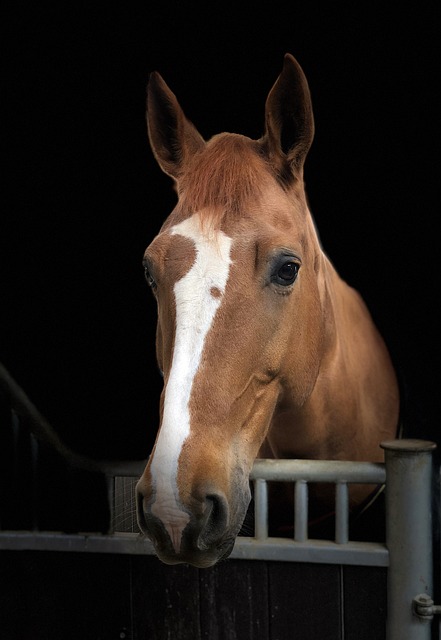Decoding Equine Expressions: The Subtle Art of Horse Facial Recognition
In the vast realm of animal communication, horses stand out for their nuanced facial expressions. This fascinating aspect of equine behavior has long intrigued researchers and horse enthusiasts alike. Recent advancements in the field of equine cognition have shed new light on the complexity and depth of horse facial expressions, revolutionizing our understanding of these majestic creatures and their emotional lives.

The Evolution of Equine Facial Expressions
The development of facial expressions in horses can be traced back millions of years. As social animals, horses evolved sophisticated communication methods to navigate complex herd dynamics and survive in diverse environments. Their facial muscles, particularly around the eyes and muzzles, became highly adapted for non-verbal communication.
Fossil records indicate that ancestral horses had less developed facial musculature compared to modern equines. Over time, natural selection favored individuals with greater facial mobility, as it allowed for more effective communication within herds. This evolutionary process resulted in the intricate facial expression system we observe in horses today.
The Science Behind Horse Facial Recognition
Recent studies employing advanced imaging techniques have revealed the intricate network of facial muscles that enable horses to produce a wide array of expressions. Researchers have identified over 17 distinct facial action units in horses, comparable to the 27 found in humans. This discovery highlights the complexity of equine facial communication and its potential for conveying nuanced information.
Equine researchers have developed the Equine Facial Action Coding System (EquiFACS), a standardized method for cataloging and interpreting horse facial expressions. This system has revolutionized the field of equine behavior studies, providing a common language for researchers and horse professionals to discuss and analyze facial cues.
Decoding Common Equine Expressions
Understanding horse facial expressions requires keen observation and knowledge of context. Some common expressions include:
-
Relaxed face: Characterized by soft eyes, droopy lower lip, and ears pointing slightly to the side, indicating contentment.
-
Alert expression: Wide eyes, pricked ears, and slightly raised head, signaling interest or mild concern.
-
Pain face: Tightened muscles around the eyes and muzzle, flattened ears, and a fixed stare, often indicating discomfort or illness.
-
Fearful expression: Wide eyes with visible white sclera, flared nostrils, and ears pinned back, suggesting anxiety or fear.
-
Aggressive face: Bared teeth, pinned ears, and a hard eye, warning of potential confrontation.
The Role of Ears in Equine Communication
Horse ears are incredibly expressive and play a crucial role in their communication system. The position and movement of a horse’s ears can convey a wealth of information about their emotional state and intentions. Some key ear positions include:
-
Forward-pointing ears: Indicating attention and interest.
-
Sideways ears: Often a sign of relaxation or mild attentiveness.
-
Pinned-back ears: Warning of aggression or extreme discomfort.
-
One ear forward, one back: Suggests divided attention or uncertainty.
Understanding these ear positions in conjunction with other facial cues provides a more comprehensive picture of a horse’s emotional state.
The Importance of Eye Expression in Horses
A horse’s eyes are perhaps the most expressive feature of their face. The size, shape, and movement of their eyes can convey a range of emotions and intentions. Key aspects of equine eye expression include:
-
Eye size: Wide-open eyes often indicate alertness or fear, while half-closed eyes suggest relaxation or sleepiness.
-
Eye wrinkles: Tension around the eyes can indicate stress or pain.
-
Eye movement: Rapid eye movement may signal nervousness or heightened awareness.
-
Eye contact: Direct eye contact from a horse can be a sign of curiosity or challenge, depending on the context.
Muzzle Movements and Their Meanings
The horse’s muzzle is highly sensitive and capable of subtle movements that convey various emotions. Some notable muzzle expressions include:
-
Lip licking: Often seen as a calming signal or sign of processing information.
-
Flehmen response: Curling of the upper lip to enhance smell, often seen in response to new odors.
-
Tight muzzle: Tension around the mouth area can indicate stress or discomfort.
-
Droopy lower lip: A sign of relaxation and contentment.
Practical Applications of Equine Facial Recognition
Understanding horse facial expressions has numerous practical applications in equine management and welfare:
-
Early detection of pain or illness: Recognizing subtle changes in facial expression can help identify health issues before they become severe.
-
Improved training techniques: Trainers who can accurately read horse expressions can tailor their methods to each individual horse’s emotional state.
-
Enhanced safety: Being able to recognize signs of fear or aggression can prevent accidents and injuries in horse-human interactions.
-
Better breeding practices: Understanding facial expressions can aid in selecting horses with desirable temperaments for breeding programs.
The Future of Equine Facial Recognition Research
As technology advances, so does our ability to study and interpret horse facial expressions. Emerging areas of research include:
-
AI-powered facial recognition: Developing algorithms to automatically detect and interpret horse facial expressions.
-
Cross-cultural studies: Investigating how horse facial expressions may vary across different breeds and environments.
-
Neuroscience of equine expressions: Exploring the brain mechanisms underlying facial expression production and recognition in horses.
These ongoing studies promise to deepen our understanding of equine communication and cognition, potentially revolutionizing horse-human relationships and equine welfare practices.
In conclusion, the field of equine facial recognition offers a fascinating glimpse into the emotional lives of horses. By honing our ability to read and interpret these subtle cues, we can forge stronger bonds with these magnificent animals and ensure their well-being in our care. As research in this area continues to evolve, it holds the promise of transforming our relationship with horses, leading to more empathetic and effective equine management practices.





